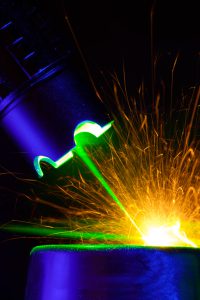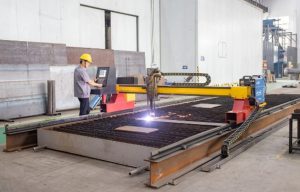Manufacturing Mondays Blog Series: May the 4th Be with Laser and Plasma Cutting Workers
Posted on byThe blog content comes from the NIOSH Manufacturing Mondays seminar series.
It’s the first week of May! This week is May 4th, a date when people celebrate that cultural touchstone: Star Wars. But don’t forget the other star wars. The famed defense program, officially designated the Strategic Defense Initiative (SDI), was announced by President Reagan in 1983, and subsequent Bush and Clinton administrations modified the original to include more workable technologies. The idea to use ground- and space-based lasers, particle beams, missiles, and other weapons to help protect the United States from nuclear attack seemed like an idea from a galaxy far away, or a nearby movie theater. While laser beams and plasma cutters may have seemed like an idea out of science fiction, this was the very point at which they were becoming indispensable techniques of mainstream manufacturing.

Laser cutting first emerged in the 1960s to drill holes in diamond dies. Though effective, the technique was heavily limited by power output. It wasn’t until the technology matured where lasers powerful enough to cut metals became more available. Modern systems range from 50 watts for small hobbyist applications to industrial systems with over 1000 watts; similarly, they can range in size from a self-contained desktop tool to an instrument with disparate components occupying the majority of a shop floor. The power output places laser cutters solidly as Class 4 lasers, which pose hazards not only to the eye but to the skin. The heat output is also sufficient to create a fire hazard and burn hazard, and to generate combustion byproducts that can be inhalation hazards. Engineering controls and training are essential to prevent exposure to laser energy, and ventilation may be used to control volatile and particulate emissions. Personal protective equipment, especially for the eyes, is also an indispensable safeguard. Numerous standards exist for laser safety, and recommended practices for laser cutting specifically. Often facilities using laser-cutting have a designated Laser Safety Officer (LSO), who is charged with ensuring safety by properly evaluating and classifying equipment, establishing protocols, and implementing controls. In addition, noise, electrical, and other machine hazards remain present.
Plasma cutting is another elegant technique from an earlier age. The technique also originated in the 1960s and became more mainstream in the 1980s. Plasma cutting is an electrical welding allied process where an electric arc is produced, and a gas is injected into it. An extremely hot (30,000 °F) plasma then accurately melts the metal below. The cutting depth ability of the unit is tied directly to the power used: a machine using 200 A of electric current may be rated to cut approximately 2.75 inches of steel. Higher amperage systems require darker eyewear and the hazards from molten metal sparks and noise are greater. In addition, the higher amperage creates greater electrical hazards.

Both laser and plasma cutting are sometimes controlled by computer numeric control (CNC) operation. This always includes a two-dimensional table and a way to move the cutter with respect to the material; more sophisticated systems can move three-dimensionally. This is dictated by a template, which can be produced by an operator using computer-aided design or other software. Computer controlled systems in many machines have advantages of limiting operational exposure but impose machine hazards such as operators getting caught in machinery during programming and code testing phases. Some injuries have occurred while CNC operators observing testing runs and code variations have inadvertently placed themselves in line with the machinery due to the code performing differently than the operator intended but possibly exactly as written. Both machine guarding and administrative controls are important to reducing the risk of these injuries.
Though laser and plasma cutting may sound like something out of a movie, the workers who use these technologies and the products they make are very much here today. While they were only in our imaginations once, who knows what may inspire tomorrow’s technologists and manufacturing workers. Happy Manufacturing Monday, and May the Fourth be with you.

RJ Matetic, MS, PhD, NIOSH Associate Director for Manufacturing
Gary Roth, MS, PhD, NIOSH Manufacturing Sector Program Co-Coordinator
Jenny Topmiller, MS, NIOSH Manufacturing Sector Program Co-Coordinator
Richard Current, PE, NIOSH Manufacturing Sector Program Assistant Coordinator
Adam Smith, PhD, NIOSH Manufacturing Sector Program Assistant Coordinator
The blog content comes from the NIOSH Manufacturing Mondays seminar series. The Manufacturing Program uses Mondays to highlight happenings within the program and throughout the world of Manufacturing. Some weeks feature seminars by internal or external speakers while others will share recent news and interesting facts related to the Manufacturing community. Many of these topics will also be highlighted here on the NIOSH Science Blog. To share your ideas for future topics contact us at mnf-program@cdc.gov.
References:
- Strategic Defense Initiative; Wikipedia
- Laser Cutter Safety; Massachusetts Institute of Technology
- Laser Hazards; Overview, Occupational Safety and Health Administration
- Recommended practices for Laser Beam, Welding, Cutting and Allied Processes; American Welding Society
- Fact Sheet No. 19: Laser Welding and Cutting Safety; American Welding Society
- ANSI Z136.1 American National Standard For Safe Use Of Lasers; American National Standards Institute
- ANSI Z136.9 Safe Use of Lasers in Manufacturing Environments; American National Standards Institute
- NFPA 70E Standard for Electrical Safety in the Workplace; National Fire Protection Association
- Welding, Cutting, and Brazing; Occupational Safety and Health Administration
Posted on by

